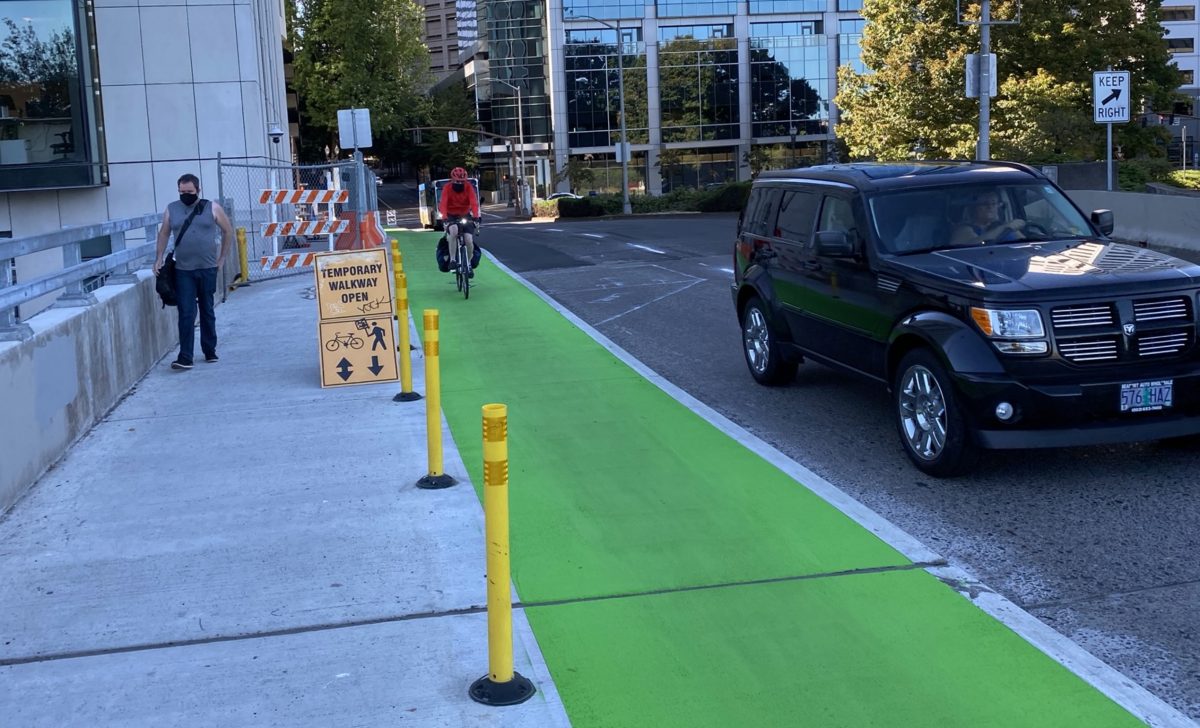
(Photos: Jonathan Maus/BikePortland)
Multnomah County is putting finishing touches on the new courthouse building next to the Hawthorne Bridge and the $325 million project included a big change to the bike lane on SW Madison.

Instead of a standard, unprotected bike lane, bicycle users now ride up on a raised path adjacent to the sidewalk. The new bike lane is grade-separated from other lanes and is colored green. There are yellow plastic wands and pavement markings to help designate the cycling space from the walking space. The bike lane returns to the roadway level just as you approach the Naito Parkway on-ramp to cross onto the bridge deck.
The video below shows a handlebar-view of the new bike lane from 1st to the bridge:
Advertisement
SW Madison is one of the busiest bikeways in Portland (at least it was before the pandemic) and it’s seen slow and steady updates for bicycle users in recent years.
In May 2019 the Portland Bureau of Transportation created a bus and bike-only lane on SW Madison between 4th and 1st avenues. And in 2013 the County added plastic wands and curbs to separate bike riders from other traffic on the eastbound bridge viaduct. PBOT’s Central City in Motion plan has a project to continue adding protection to the bikeway eastbound onto Hawthorne Blvd. That project is slated to begin construction next month.
Another related project that will impact this section of bikeway is the new signal coming to the Naito Parkway on-ramp to the bridge. PBOT broke ground on that project back in July.
A County spokesperson told us this morning that the courthouse is slated to officially open October 5th.
Here are a few more images:
— Jonathan Maus: (503) 706-8804, @jonathan_maus on Twitter and jonathan@bikeportland.org
— Get our headlines delivered to your inbox.
— Support this independent community media outlet with a one-time contribution or monthly subscription.


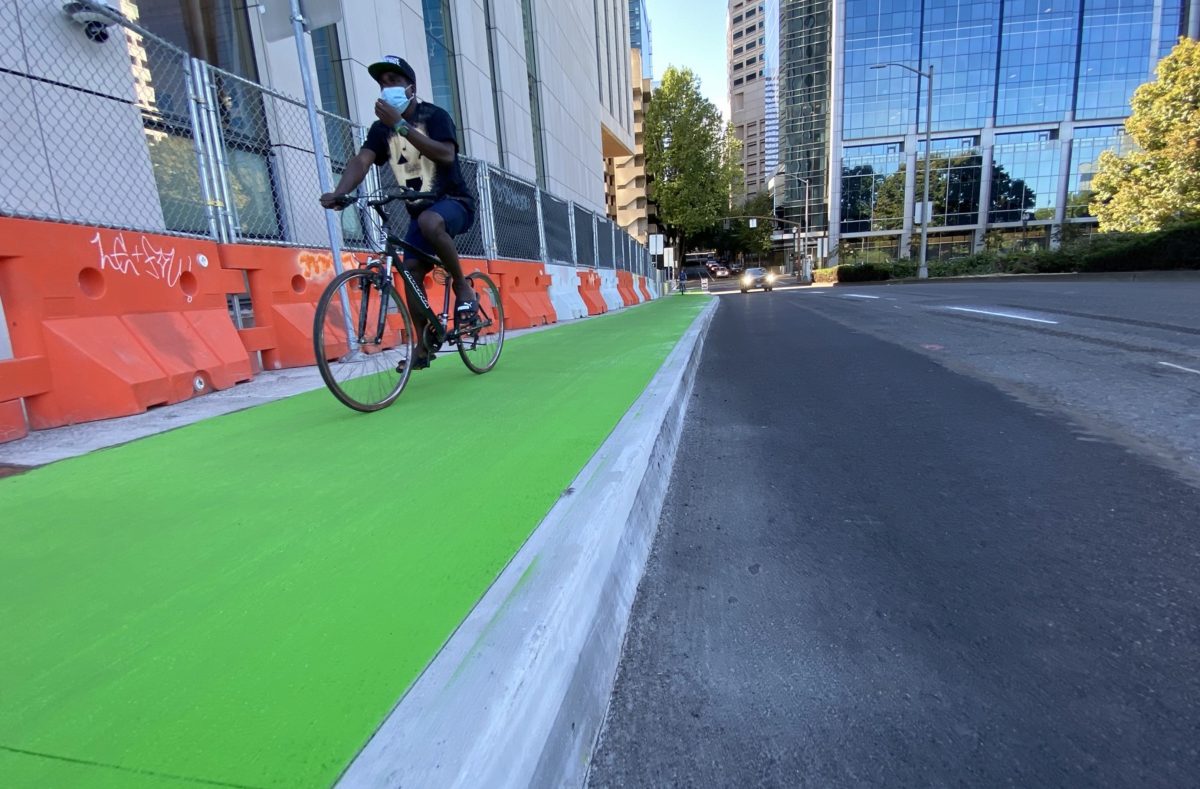

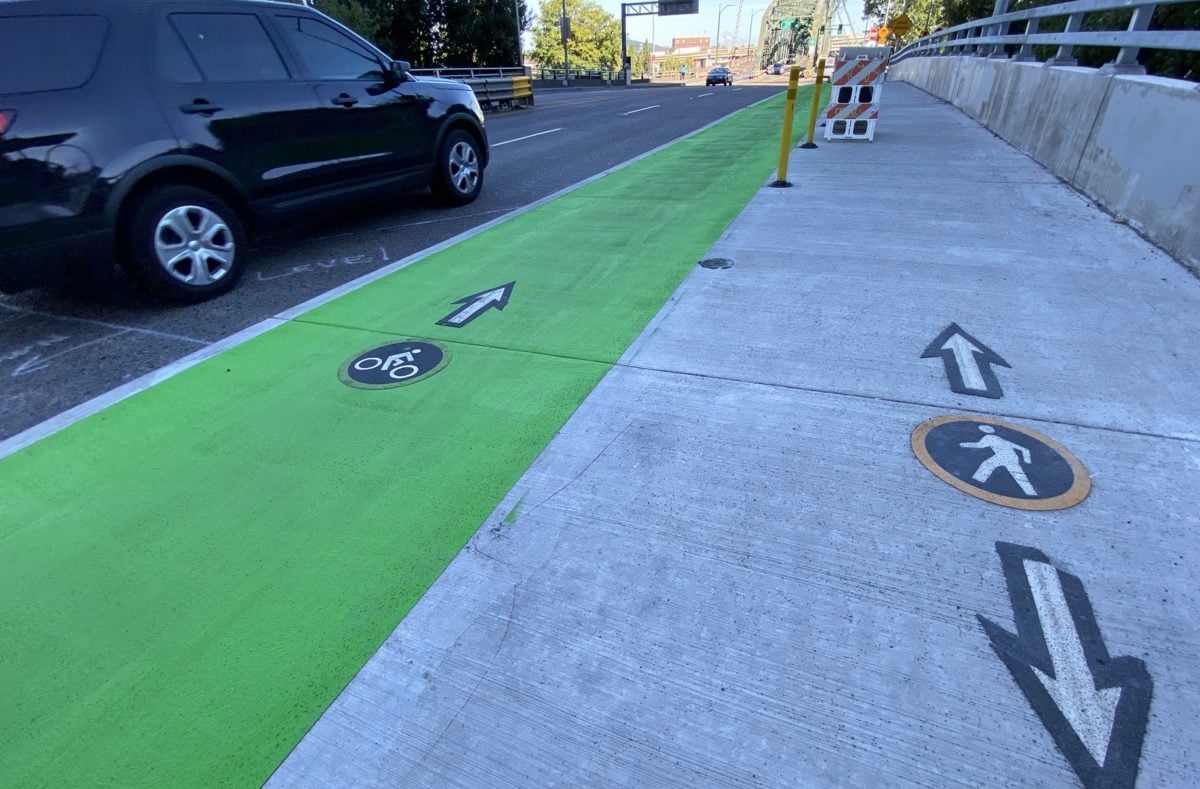

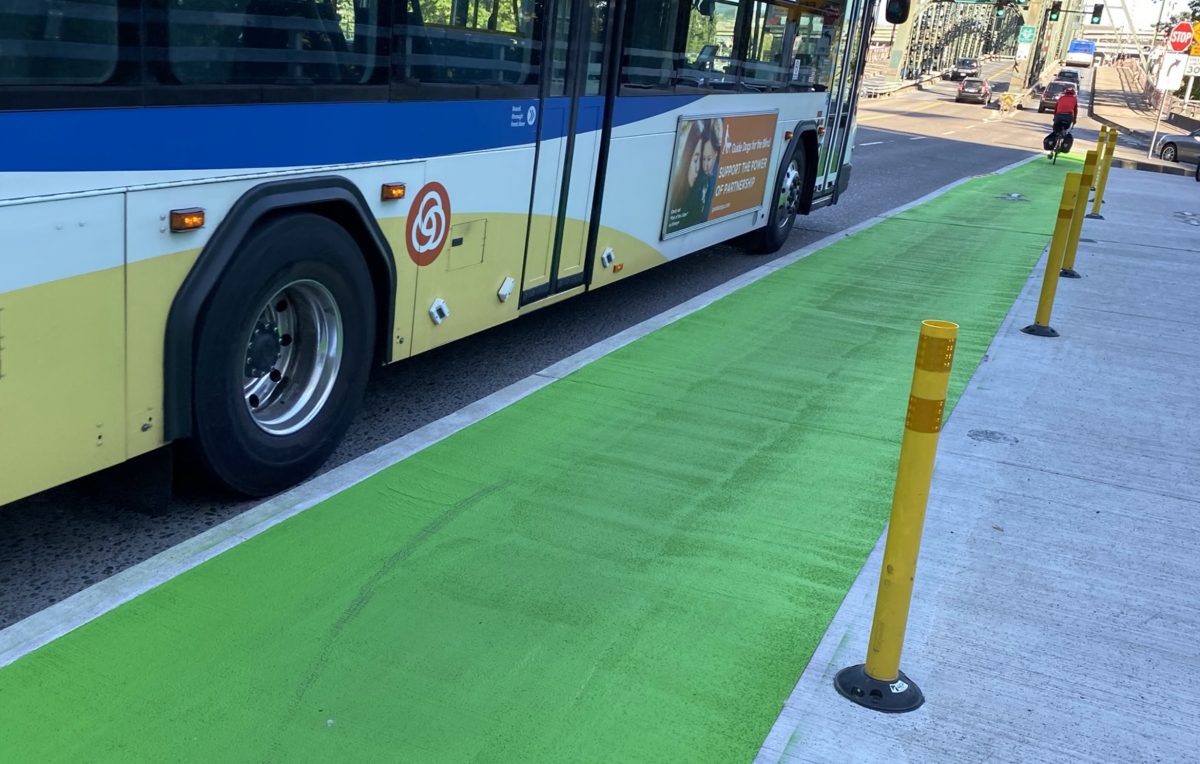
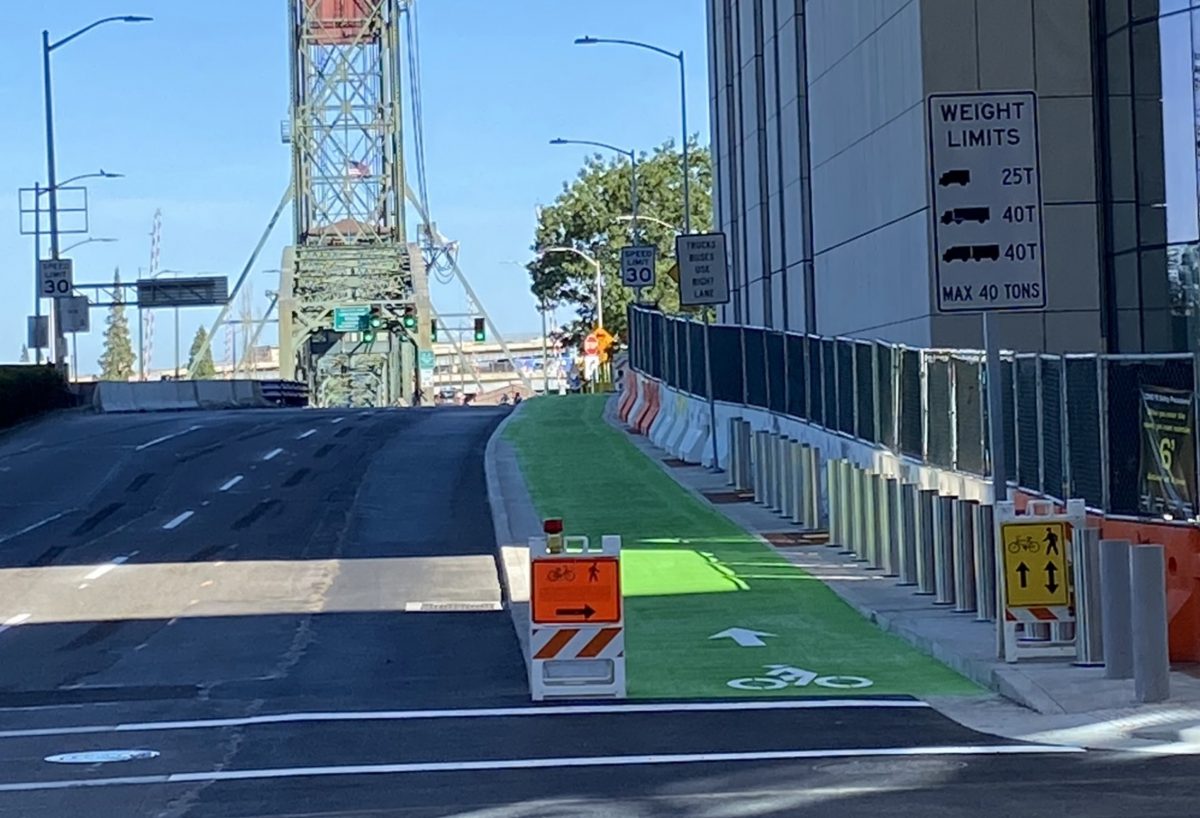

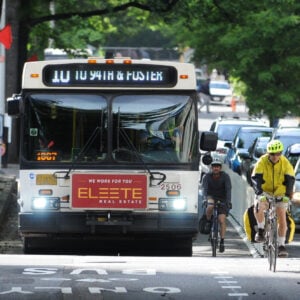
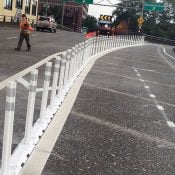
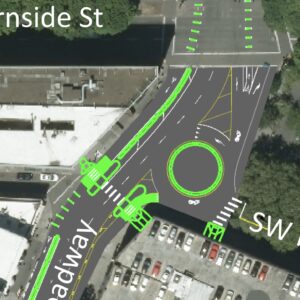
Thanks for reading.
BikePortland has served this community with independent community journalism since 2005. We rely on subscriptions from readers like you to survive. Your financial support is vital in keeping this valuable resource alive and well.
Please subscribe today to strengthen and expand our work.
Projects like this show that PBOT knows how to build quality bike infrastructure, they just choose not to build it anywhere that isn’t in the central city.
It’s a truism in any city – city staff tend to design and build the best infrastructure that they themselves are most likely to use. The closer the infrastructure is to where they live, work, and play, the better it will be and the sooner implemented.
The reverse is equally true – one can reasonably assume there are not many (or any?) PBOT staff who live in, work, nor play in East Portland nor outer SW.
Correction, anywhere that affects parking or car “flow.”
This is a Multnomah County project, not PBOT. County is responsible for the bridges.
Oh doh! Sorry, I should have realized the quality is far too high for PBOT work.
Hmm.. in my experience living downtown (as a low-income, car-free PSU student) aside from a few approaches to major bridges and some roads near the riverfront, there is hardly any decent bike infrastructure at all. Inner Southeast and inner Northeast feel vastly richer and more bike-friendly in terms of bike infrastructure than most of the central city.
Par for the course for OP, who for some reason always has an axe to grind about how much PBOT spends in Central City, while conveniently ignoring the predominately awful conditions for cyclists there (NW included).
PBOT’s Vision Zero map shows awful conditions in E Portland but not so much in NW Portland.
https://pdx.maps.arcgis.com/apps/MapSeries/index.html?appid=5385b143768c445db915a9c7fad32ebe
Inner NW Portland also has 4 Neighborhood Greenways, 5 protected/buffered bike lanes, and several multi-use paths. Portland E of 205, on the other hand, has one incomplete Neighborhood Greenway (despite the funding of multiple Neighborhood Greenways a decade ago) and high-speed arterials that often represent the only routes through large superblocks
Until and if NWIM passes, some of those NW greenways are “in name only” with unacceptably high automobile traffic counts.
That said, I do find it pretty comfortable to bike in inner NW. YMMV.
Hell yeah I have an axe to grind. The “greenway” I have to take to get to the rest of the city has 5 uncontrolled intersections I have to pass through, no speed bumps or much more actual traffic control devices, and we don’t even have bike lanes starting at the cut.
PBOT has poured millions into NW in the last five years. If the infrastructure is bad, it’s because PBOT is incompetent. It’s not for lack of spending money.
What do you think we should do? We have motorist using our neighborhood as a drag strip seven nights a week now. Should I just be super amped that the wealthy in NW are getting yet another infrastructure improvement.
The conservative anti-working class sentiment by bike advocates is THE major reason cycling is dying in Portland.
The central city advocates who are given the loudest voice by PBOT don’t know anything about the conditions in NoPo or care, neither does PBOT.
Dead on.
The pervasive anti-houseless bigotry and championing of gentrification by real-estate speculators on this blog are good examples of this.
Portland is fast transitioning into a city run by and for the rich and many cycling advocates (both grassroots and nonprofit) are cheering this on.
Hey, maybe when the bike mode-share gets to sub 1%, some of these “bike advocates” will get their head out of the sand and demand real change.
Bikes are a great tool for the working class to get around, but PBOT, the BAC and bike advocates in general are hyper-focused on building more infrastructure in non-working class communities.
Have you visited the Gateway area recently?
A good improvement but it would be nice if the elevation were maintained where cars merge. Cyclists and pedestrians have the right of way there, so why should their paths be disrupted?
They’re implementing a signal there so nobody will have the right of way all the time. But I do agree that it would be nice to have only a gradual elevation change. I hope the pedestrian part has a full ADA-compliant ramp, while the cycle path section has a very gradual ramp.
It still would be best practice to have a raised concrete path connect across the slip ramp. Harder for drivers to speed and roll through a stop sign or red light when they are basically going over a giant speed bump.
Does anyone know if stopping everyone – bikes and cars, via signals at intersections – is an explicit (or implicit) component of Vision Zero? Seems to me that the lower the speed, the lower the potential for injuries and deaths. But people *like* being able to flow, in a car but especially on a bike, where momentum is so much harder to generate and to maintain. All of these new signals could generate a backlash.
Although raised paths drastically reduce vehicle encroachment, I’m not really a fan.
Among other things, they make it more difficult and dangerous for cyclists to cleanly pass each other. This is especially an issue when riding uphill, wider cycles are involved (e.g. trikes or trailers), and/or slow riders don’t ride to the right.
Sure, but I’ll happily take the tradeoff of having to have a little bit of patience for a limited stretch of road in order to have the safety improvement. The wear on the previous paint alone showed how needed this is.
Is it really a safety improvement? Or do you just *feel* safer? How many cars actually encroach in bike lanes? And how many cyclists have been injured by falling off a raised lane into traffic?
Does that happen? I’ve never seen it or heard of anyone doing it.
Perhaps you could slow down and wait for a safe and comfortable time to pass? As a slow rider that’s been using a bike for transportation for more than 20 years, it’s impossible to count all the times that fast riders put me in unsafe and startling positions. I refuse to ride too close to a car door or pedestrians or even concrete walls to make it so that the fastest people can maintain their speed.
The time it takes to be kind and courteous to all ages and abilities out there will cost you seconds. Maybe a minute. Maybe 3 minutes if it’s extreme. I’m so thankful that our streets aren’t designed for the fastest racers out there. That goes for driving and biking. Your photo in the white water is a good metaphor. You like it fast and swift with a little bit of danger. How many people can kayak at that level? Seems more people can use their boats on calm rivers. That’s what accessibility means. Available to the widest audience possible.
You are making my exact point. You shouldn’t feel pressed up against a wall, peds, doors, or anything else.
Portland cycling etiquette is already abysmal — it’s the worst I’ve encountered anywhere I’ve lived. The Hawthorne bridge is a poster child of this dynamic — you’ll see people do close passes at 25mph+ but it happens everywhere, including where there’s plenty of room for the passing rider to pull out.
Making it literally impossible to do a safe pass will only make things worse, especially now that a growing number or riders who lack both judgment and handling skills are getting e-bikes.
I agree that infrastructure must work for the widest audience possible. Given that all kinds of cyclists go all kinds of distances on all kinds of bikes so they go very different speeds by necessity, infrastructure that crams them all close together doesn’t qualify as the inevitable outcome is ultimately usable only to a minority.
We’re on the same page about the 25+ MPH passes. However, it seems your point then is that bike infrastructure shouldn’t be there if it can’t accommodate the fastest riders at all times. Wasn’t a good idea to design our streets that way for cars and now we should follow that same approach for bikes?
The Bridge is a fixed amount of feet wide. Just like anywhere, there are times when the real world strikes and we have to adjust to the environment we’re riding in. Here, you’re complaint is that you think it’s too narrow to pass safely and keep your speed. My point is that the world isn’t perfect and it would be better to slow down and wait for a safe and comfortable place to pass. This may take the half mile of the bridge when it’s super busy. But, usually, it’s a matter of waiting until the slower rider passes a pedestrian or gets off a narrow part of the path. It’s literally a matter of seconds for your total ride. You don’t have to make assumptions about how far I ride because I’m slow. It just takes me longer because of muscular problems and the bike is what keeps me healthy and sane. It always sucks when people can’t take a few extra seconds as it would be easily life changing if a fast rider risks my safety and it doesn’t work out.
I’m not sure why you think I buzz people — I wouldn’t complain about etiquette or safety if I did. I take the traffic lane on Hawthorne if the path is crowded and do the same on the Broadway and Steel bridges. Very few cyclists do this. I don’t take MUPs for the simple reason that I do not think bikes going faster than jogging speeds belong on them at all. I don’t ride near people I don’t know because it’s dangerous and stupid.
The time lost is not a matter of seconds. It can be minutes on a single bridge or hill with some riders who literally move at walking speeds. And then there is the rest of the route to deal with. If I had to ride Google estimate cycling speeds, it would add more than a half hour each direction on most work and utility trips.
The average commute in the PDX area is 7 miles one way. This means the average person needs to move at a reasonable pace in order for cycling to be feasible — this is especially true for those who have longer than average commutes. Anything presented as cycling infrastructure should allow for reasonable cycling speeds. Otherwise, driving makes too much sense.
My point isn’t that bike infrastructure shouldn’t be there. Rather, it’s that it needs to be designed so you can do normal things like pass people. Dropoffs, wands, curbs, walls, and the like prevent these things. We shouldn’t advocate for them except when they’re really necessary — which will rarely be the case.
In any case, regardless of what I do, a lot of people will do a lot of dangerous passing. It’s an obvious and avoidable problem which people insist on repeating over and over. Then they wonder why people don’t ride.
You ride the steel grate road bed on the Hawthorne? What pressure you running?
I ride 95psi front, 105psi rear on 700/23s. Current tires are Conti 4000S2.
You’d think it would be awful on the metal, but it’s not that bad since there’s no braking or steering and it’s not that far. Frankly, control feels better than on the many smooth plates all over the place. Brisk pace highly recommended.
Good for you, but I won’t be taking the lane on the Hawthorne Bridge anytime soon or ever.
99.999% of riders in Portland would never ride the steel grated deck of the Hawthorne, except during the Bridge Pedal.
I don’t think I said anything about how you ride. I was reacting to your point that bike infrastructure that makes fast people slow down is a failure. My point is that the goal should be bike projects that work for everyone and that the goal shouldn’t be speed over everything. It’s possible for you or any rider to slow down and wait for a safe and comfortable chance to pass. It’s not possible for me or someone carrying a heavy load, or others to magically get the ability to speed up. We are traffic and there are times when there isn’t the width to give you space to not slow down. I do see it as the same idea that car drivers have that slowing speeds is inherently an assault on their ability to get from a to b.
I have no issue with slowing down and waiting for safe passes — I do it on literally every ride. I have no issue with people going slowly. One of my bikes is slow and heavy — I’ve hauled 50lbs of dog food and 2 cases of beer on it.
But you do need reasonable opportunities to pass. I’d say that’s possible everywhere except where the cycling space is artificially kept narrow. IF you don’t have wands, curbs, walls, etc, a clean pass in the vehicle lane is always possible. Interstate is a great example of where there’s a great bike lane for much of it and a barrier would be a horrible thing.
We all need to get where we’re going, and if some people take the position that others don’t need to get where they need to be, they shouldn’t be surprised when they aren’t treated kindly on the roads. In my experience, most people are less patient than I.
If we really want to make sure hardly anyone cycles, the best way to accomplish this is by building infrastructure that ensures no one can go faster than the slowest rider without passing too closely.
This will discourage seasoned and novice cyclists alike. The riding experience will be scary for less confident riders constantly being overtaken and frustrating for those traveling more than trivial distances who are constantly blocked.
Add in public transport that’s already hopelessly slow, and we can wonder why people stay in their cars.
This would explain why ridership is so high in places like Houston with no bike infrastructure, and so low in places like Portland and NYC with more bike infrastructure.
Though, to be fair, riding rates in Portland were high (by US standards, at least) even before we started building infrastructure, and while they have risen since, they do not seem well correlated to infrastructure spending.
I think the concept that more infrastructure results in more riders is axiomatic to many, but it is not well supported by our experience.
From the research I’ve seen on bike travel behavior, the likelihood of bicycling has more to do with relative density of the population, the built environment (to a point), and the close proximity of useful destinations, rather than the infrastructure implemented. Bicycling works best for trips of over 3 miles and under 7 miles, give or take (from a peer-reviewed study in Bangladesh as I recall.)
In college towns, which typically have a lot more bicycle riders per population than most other communities, the main user densities are in areas of high housing density that are mixed with local businesses and campuses, irregardless of how much or how little bicycling infrastructure has actually been implemented. In those same communities, the outer suburban sprawl has much less usage by bicyclists, even when there is good infrastructure, just because of the longer distances to get anywhere useful, and cyclists are more likely to be recreational rather than cycling for transportation.
In larger cities like Chicago you tend to see more bicyclists in the denser inner parts of the city, but not as much (relatively speaking) in the central skyscraper core except by tourists, and in the outer suburbs except by recreational riders. Downtown Portland isn’t particularly dense, never has been, it’s more like a suburb of some fictional larger city, something bigger than Eugene or Spokane, but neither here no there – a big town but not a big city. It’s outer suburbs have never had good or even ok ridership, and even SW, North, and East Portland are effectively outer suburbs on a large town. In inner Portland (and Seattle, DC, and other medium cities), certain parts of town have lots of varying housing types in close proximity to varying businesses, job sites, and education – a healthy mix. But other parts of town have widely-separated land uses caused by dumb zoning, so everything you want to visit is far from where you live or go to school. And unfortunately the city has only exacerbated this issue by its well-meaning land use policies since the 1930s, when coincidentally the car really took off.
Anyway, I could go on forever with my mansplaining, but I’ll stop here.
The yellow plastic wands between pedestrians and bike riders are a very strange idea.
Not a fan either. If I’m a cyclist and there’s no pedestrians around I’d like to be able to pass slow cyclists if necessary. Similarly, if I’m a runner and there’s no cyclists around, I’d like to easily be able to go around walkers. These posts make those possibilities significantly more difficult. Keep the green paint delineation of course, but we don’t need the posts. I’d rather the money spent on those posts be used to create a post-separated bike lane somewhere else in town.
I don’t like the look of that edge… If you fall off of it (say passing someone), looks like you can’t just roll back into the lane w/o stopping. That is, presuming that the fall off the edge doesn’t dump you on your ass in the first place.
Here’s a thought — don’t pass if it’s not safe to pass?
This is a concern I have with the Hawthorne bridge in general, but more so with the actual bridge span. Every time I cross it I worry that a pedestrian or another biker will accidentally knock me off the path and into the busy travel lane. That it hasn’t happened yet to me is a miracle. I would really love to have Tilikum bridge style barriers between the multi-use path and the car travel lanes someday.
This is exactly the kind of situation I was thinking of.
Like all new bike infrastructure this was fine before, though it may be better now and certainly would have been better if they had asked me about it. It will make it harder to pass, but I’ll pass anyway unless I think it is unsafe to pass which I am the sole determiner of, but of course it is always too damn close. Regardless, whichever organization is responsible for making this, they didn’t do it the way I would, even though the deck I built a few years ago is a death trap. For the slower cyclist it will make them more comfortable since they have been doing this bike commuting thing for years and used to be fast, but now they really understand what cycling is about, and it isn’t speed. Ya know the secret to bike commuting is waterproof pants over jeans, otherwise you’re sweaty before you get to work at the art coop that doesn’t exist anymore in innner SE. All the people who commute on race bikes are racist, misogynists, definitely gentrifiers and probably have a BMW they don’t even drive. I could admit this is better, but there is certainly somewhere, anywhere in the six quadrants of this city, that didn’t get something they need, so I must comment on it, particularly if I think it is east of 82nd ave.
Did I miss anything?
You forgot to comment about the shade of green they are using and how it affects city-wide equity.
You’re good David, and so right. I forgot to mention how the green paint will be too slick for skateboard wheels, and way too rough for 23c race tires, but everyone rides gravel bikes now, at least all the man shoaling white collar corporate types with money left, so they will of course continue to be the least impacted by the forward march of progress through the golden age of easy motoring, or something like that which would easily offend at least one owner of a bike shop in N. Portland.
That’s funny, PS, but not very helpful. There are actually aspects of this project (and every project) that make a life-or-death difference.
Looks lovely, but they might have gone overboard with the plastic bollards. I think half as many would have gotten the message through
Well, um, ok. I ride from the vicinity of Hwy 217/US-26 into town, over the Hawthorne Bridge and then out to a weaving studio in SE. I found the raised bike lane before they painted and signed it, and was pleasantly surprised this week to find it a cheery “bicycles here!” Green. I had been riding down from Washington Park, all the way down Salmon to 3rd, (like I’ve done for over a decade) but one day, took a right on Park, and a left on SW Madison, and it was a TOTAL game changer. Much less traffic and exponentially better pavement.
The raised edge doesn’t bother me nearly as much as the raised edge on the actual bridge. I only ride in the “bike” section if there are pedestrians.
So, yes, I like it very much.